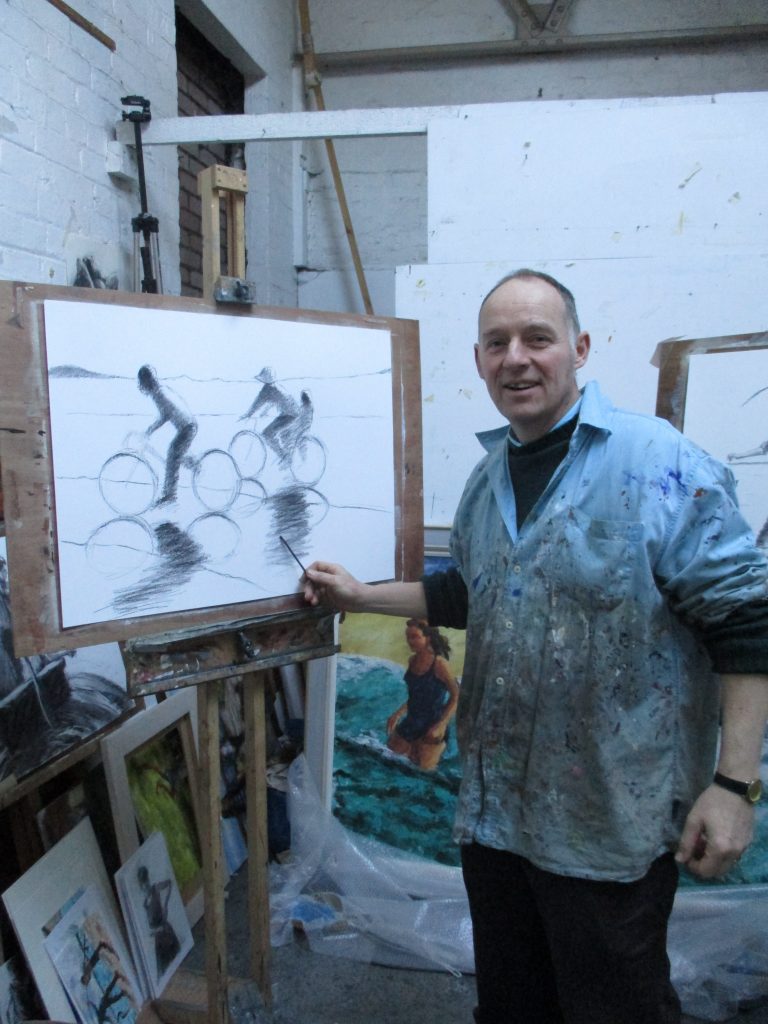Damian Callan Painter
You title your art as figurative art, discuss this using image to explain the terminology.
Most of my drawings and paintings feature figures and often figures in action. I tend to lose interest in images that are figure-free. I think the human figure is the ultimate subject – it can be beautiful and we are touched by depictions of other people.
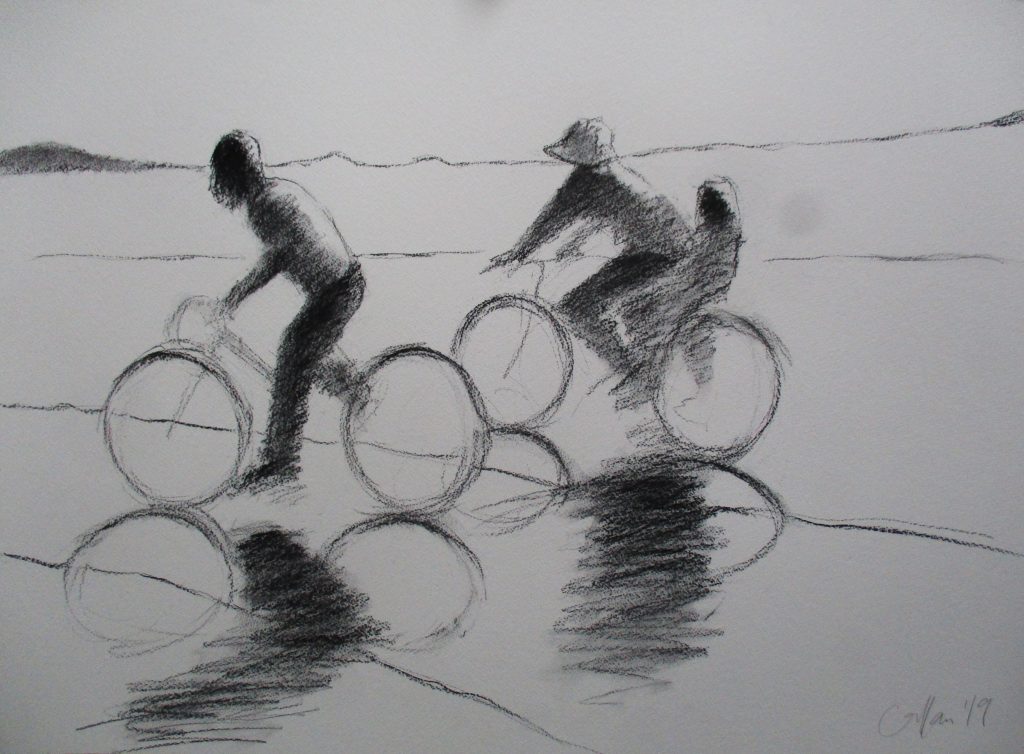
Bicycles Shadows, charcoal 55 x 77 cm
What made you leave science for art?
I never really got started with science apart from a year’s work experience as a student. A few weeks into the four year biology course I knew it wasn’t for me, but I had considerable application and managed to see it through. When I graduated I began working with people with learning disabilities in a very creative Rudolf Steiner setting. That led me to eventually take a second degree in Drawing and Painting at Edinburgh College of Art.
You have had an unusual residency in a hospital. Can you expand on what this time involved?
I spent time in the Liberton Hospital just outside Edinburgh and homed in on the occupational therapists and physiotherapists who were teaching stroke victims to walk and regain other basic motor skills all over again. It was miraculous work and very moving to witness. I produced a series of paintings of a man taking his first steps with the help of a therapist. These were done on seven small panels and decorated with an imitation gold leaf. I was aiming at an almost religious quality to the images.
Teaching is a part of your week – discuss this aspect of your painting week.
I teach 2 -2.5 days a week, mainly in my studio and also at The National Gallery. Students come to me to learn to paint the figure in oils. At the gallery I run a drop in event that encourages people to ‘have a go’ at drawing in public – something that seems to work through a kind of spontaneous magic and many have a revelation and experience a real breakthrough and say they want to take up drawing more seriously as a result. I enjoy teaching and learn a terrific amount in the process. I often find that I’m urging students to try a particular approach and then realise it would actually suit me very well to do the same…
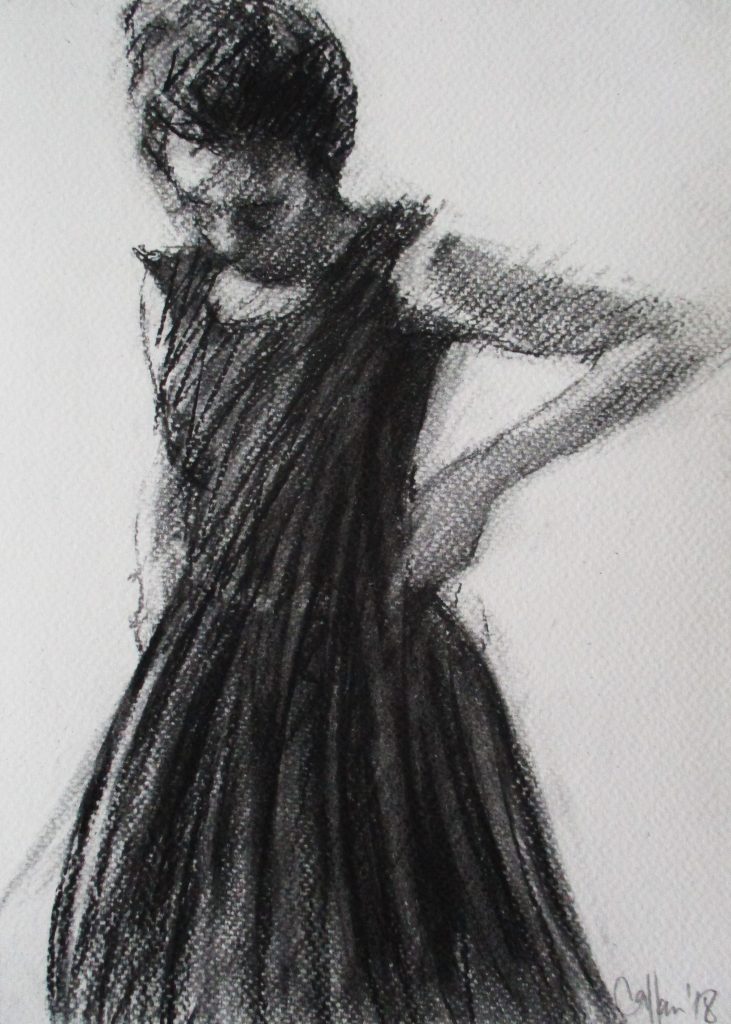 Best Dress III, III charcoal 35 x 25cm
Best Dress III, III charcoal 35 x 25cm
Location is a major part in your art teaching – Explain how you move from location to location to expand the joy of plein air painting.
One of the courses I run alternates between a day drawing at a particular Edinburgh location ifor example the swimming pool, the canalside, a hotel lobby, an auction house showroom and a then day in the studio with a portrait model where the students put together a composition based on the model’s pose and their location drawings as a background for the figure. Its great fun going behind the scenes to these different places and there is always so much material for paintings. In the summer I take groups out in to the landscape and to the coast to produce plein air oil paintings. There is a wonderful compliment between the changing Scottish weather and working alla prima with oil paint. It is possible to change or modify your painting in response to the drama of the light and changing scene.
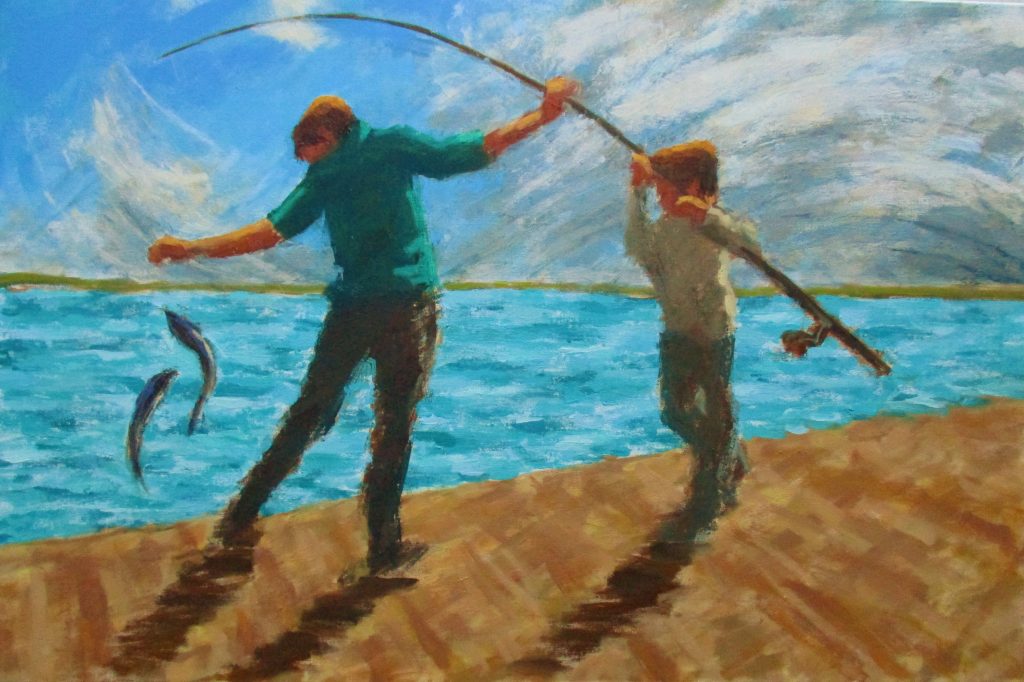
Catch, oil on canvas 61 x 91cm
When you paint with oil you work on board not canvas, why?
I work on a mixture of canvas, board and prepared paper. The weave of the canvas is great for allowing you to build up layers, but the hardness of board is helpful when applying paint with a roller (which I often do).
Movement is in your work, very often showing the pure joy that children show through movement, discuss this aspect of your work.
The one thing that I really learnt at Edinburgh College of Art was drawing the figure. We had regular life drawing classes and were taught anatomy by the great George Donald. This inspired me to work with the figure. But it wasn’t until I started painting moving figures (based on bathers in a local pool that had a wave machine) that my work really took off. I think there is something in the elusiveness of a moving figure that helps me work in a more spontaneous and lively way. I continued painting swimmers and athletes for a few years until our children were born and then it just seemed perfect to start depicting them and their activity.
The children you paint are often your own children. How do they feel about your sharing them in this way?
I quote my daughter; she says she feels, ‘Honoured and respected…’ I suppose they’ve never really known anything else. When they were younger people would ask ‘Don’t you mind selling the paintings, wouldn’t you rather keep them?’, but I didn’t mind because we still had the children. Now that they’re growing up and leaving home, there are a few paintings I wish I’d kept.
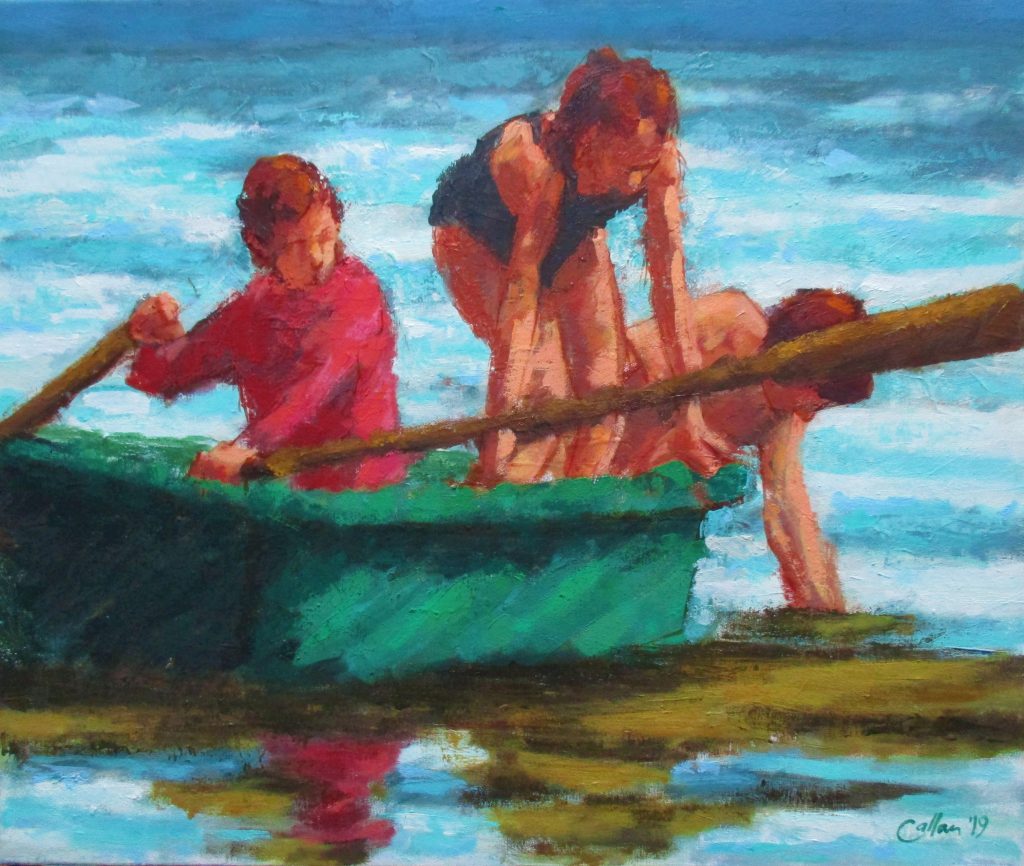 Leaving the Boat, oil on canvas 50 x 60 cm
Leaving the Boat, oil on canvas 50 x 60 cm
Discuss the obvious comparison of your works Blue Dress I with the work of Degas.
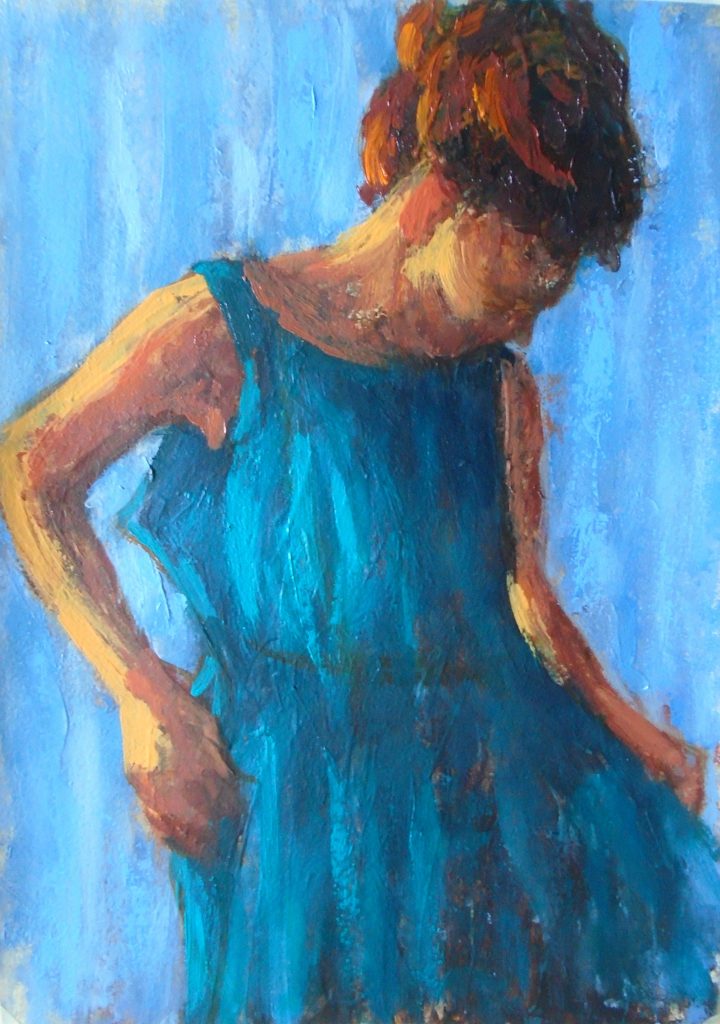
Blue Dress I, oil on paper 35 x 25 cms
I love Degas’ work and was very lucky to be asked to produce a book describing and emulating his technique. I learnt an enormous amount by examining and exploring his different approaches in order to explain them to others. He described his technique as ‘a series of operations’ and was quite scientific in the way he experimented. I have tried to emulate this aspect and in paintings like Blue Dress I and II I have built up layers in stages often changing from loose colour to drawing lines in order to add definition.
Can you expand on your technique of drawing without lifting the charcoal from the page?
I encourage my students to begin their drawings with a single continuous line formed by not lifting the charcoal off the page. It is one of those right brain approaches; a more intuitive or instinctive way of working that not only creates livelier drawings, but often produces more accurate observation. I use this technique myself and try hard not to miss the beauty of the first unselfconcious marks that are generated. The challenge is to develop the drawing to make it more substantial without losing that initial delicacy.
Take ‘Harbour Wall’ and discuss your use of charcoal.
Like many families, one of our summer holiday challenges is to throw ourselves off the high harbour wall into the cold sea water, this often seems to happen just before tea time. The children were lined up waiting for everyone to have the courage to jump together and I was struck by how heroic they looked – like Olympians about to do something very brave. I sketched out the scene with the help of some photographs and using the continuous line start. Then gradually built up areas of tone and shade to solidify the figures. I wanted to show their tentativeness and anticipation through a lightness of touch and charcoal can be perfect for this sort of sensitivity.
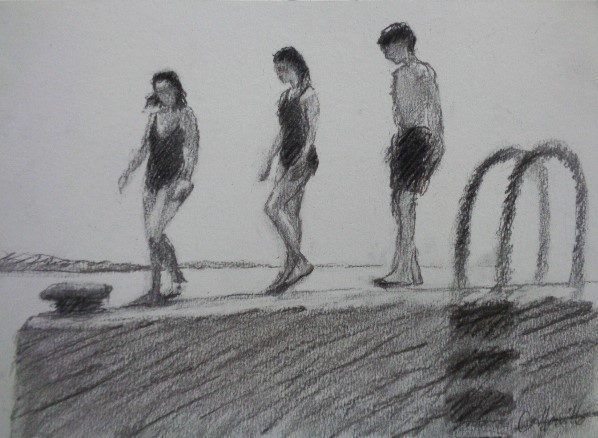
Harbour Wall, charcoal 25 x 35 cm
You are currently having a solo exhibition at Union Gallery in Edinburgh…
How was the exhibition given its title ‘Moving Images’?
I wanted to be ambiguous about the movement in my subjects and the way they move me personally.
What lead you to fill the exhibition with so much sunshine and not a spot of rain?
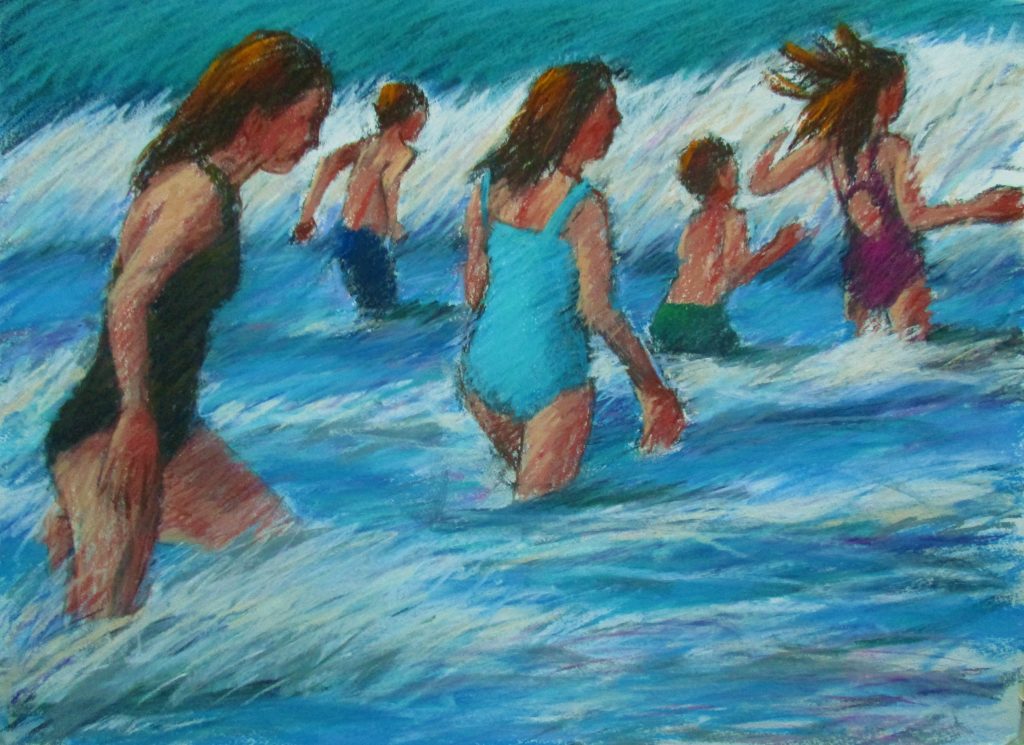
Swimming after the Storm, pastel 55 x 77 cm
Ah yes, ‘Into each life a little rain must fall…’ (especially in Scotland). I love the drama of sunlight and many of the scenes in these paintings are from the Hebrides where the weather changes so rapidly that sunshine can be short-lived and a reason to celebrate when it does burst through. When the sun comes out on the West Coast of Scotland there is no place on earth more beautiful – who wouldn’t want to paint that?
Contact details:
Damian Callan
damian.callan@gmail.com
Damian Callan, EDINBURGH, Scotland
Interview by Deborah Blakeley, March 2019
Think a colleague or friend could benefit from this interview?
Knowledge is one of the biggest assets in any business. So why not forward this on to your friends and colleagues so they too can start taking advantage of the insightful information the artist has given?
Other artists you may be interested in:


